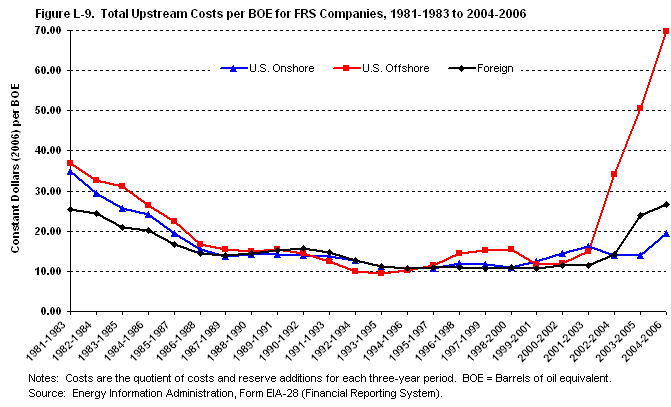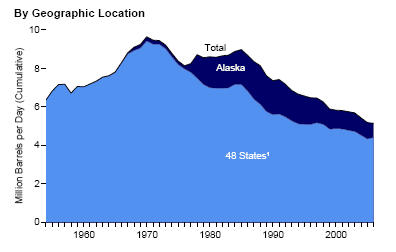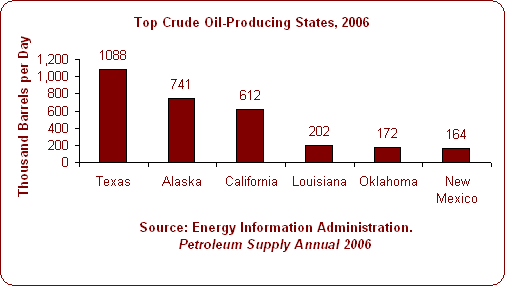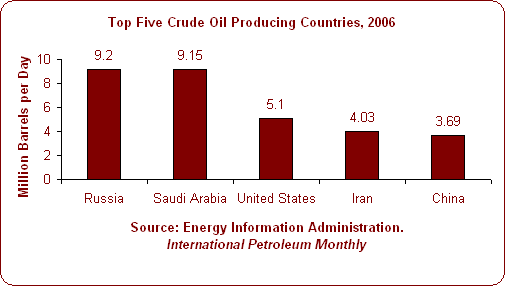|
Crude Oil Production
|
||
|---|---|---|
|
Last Updated: January 2008
Next Update: January 2009 How Is Crude Oil Formed? It is generally believed that crude oil was formed from the remains of animals and plants (called biomass) that lived millions of years ago. Over eons the biomass was covered by layers of mud, silt, and sand that formed into sedimentary rock. Geologic heat and the pressure of the overlying rock turned the biomass into a hydrocarbon-rich liquid that we call crude oil, and eventually forced it into porous rock strata called reservoirs. There are also formations or deposits of hydrocarbon-saturated sands and shale where geologic conditions have not been sufficient to turn the hydrocarbons into liquid. How Is Crude Oil Produced?Wells are drilled into oil reservoirs to extract the crude oil. "Natural lift" production methods that rely on the natural reservoir pressure to force the oil to the surface are usually sufficient for a while after reservoirs are first tapped. In some reservoirs, such as in the Middle East , the natural pressure is sufficient over a long time. The natural pressure in many reservoirs, however, eventually dissipates. Then the oil must be pumped out using “artificial lift” created by mechanical pumps powered by gas or electricity. Over time, these "primary" methods become less effective and "secondary" production methods may be used. A common secondary method is “waterflood” or injection of water into the reservoir to increase pressure and force the oil to the drilled shaft or "wellbore." Eventually "tertiary" or "enhanced" oil recovery methods may be used to increase the oil's flow characteristics by injecting steam, carbon dioxide and other gases or chemicals into the reservoir. In the United States, primary production methods account for less than 40% of the oil produced on a daily basis, secondary methods account for about half, and tertiary recovery the remaining 10%. Extracting oil (or “bitumen”) from oil/tar sand and oil shale deposits requires mining the sand or shale and heating it in a vessel or retort, or using “in-situ” methods of injecting heated liquids into the deposit and then pumping out the oil-saturated liquid. What Affects Production Costs? Reservoir characteristics (such as pressure) and physical characteristics of the crude oil are important factors that affect the cost of producing oil. Because these characteristics vary substantially among different geographic locations, the cost of producing oil also varies substantially. In 2006, average production costs (or “lifting” costs, the cost to bring a barrel of oil to the surface) ranged from about $4 per barrel (excluding taxes) in Africa to about $8.30 per barrel in Canada; the average for the U.S. was $6.83/barrel (an increase of 23% over the $5.56/barrel cost in 2005). Besides the direct costs associated with removing the oil from the ground, substantial costs are incurred to explore for and develop oil fields (called “finding” costs), and these also vary substantially by region. Averaged over 2004, 2005 and 2006, finding costs ranged from about $5.26/barrel in the Middle East1 to $63.71/barrel for U.S. offshore. While technological advances in finding and producing oil have made it possible to bring oil to the surface from more and more remote reservoirs at ever increasing depths, such as in the deepwater Gulf of Mexico, the total finding and lifting costs have increased sharply in recent years.
The first oil well in the U.S. was drilled in Titusville , Pennsylvania in 1859. Drilling activity and crude oil production expanded slowly to supply mostly lubricants and kerosene for use in lamps to replace whale oil. Production began to accelerate in the late 1800’s as crude oil refineries produced new petroleum products to meet demand for fuels and products by a rapidly industrializing country and the growing number of internal combustion engines. In 1859, U.S. production was about 2,000 barrels; in 1879 it was about 19 million barrels and in 1899 about 57 million barrels. (A barrel contains 42 U.S. gallons.) U.S. crude oil production peaked in 1970 and has declined gradually since then. In 1970, domestic production of crude oil (including lease condensate2) averaged 9.64 million barrels per day (MMbbl/d). In 2006, total U.S. domestic crude oil production, including Federal offshore, averaged 5.102 MMbbl/d, a decrease of about 47% from 1970. Historical U.S. Crude Oil Production, 1954 to 2006
The top six crude oil-producing States in 2006 (and their percent share of total domestic production) were Texas (21%), Alaska (15%), California (12%), Louisiana (4%), Oklahoma (3%), and New Mexico (3%). Production on Federal offshore-leases in the Gulf of Mexico in 2006 was 1.3 MMbbl/d, about 25% of total U.S. production.
Total world production of crude oil (including lease condensate, but excluding natural gas plant liquids3) in 2006 was 73.54 MMbbl/d (preliminary). The top five oil producing countries, which together accounted for about 43% of total world production, were: Russia (9.25 MMbbl/d), Saudi Arabia (9.15 MMbbl/d), the United States (5.1 MMbbl/d), Iran (4.03 MMbbl/d) and China (3.69 MMbbl/d). The Organization of Petroleum Exporting Countries (OPEC), which includes Saudi Arabia, produced 32.1 MMbbl/d or about 44% of the world total.
1. For companies reporting to EIA’s Financial Reporting System (FRS). It does not include state-owned oil companies. 2. Lease
Condensate: A mixture consisting primarily of pentanes and heavier
hydrocarbons which is recovered as a liquid from natural gas in lease
separation facilities.
3. Natural Gas Plant Liquids: Hydrocarbons in natural gas that are separated as liquids at natural gas processing plants, fractionating and cycling plants, and, in some instances, field facilities. More
information on this subject can be found in the following EIA publications: Performance Profiles of Major Energy Producers, Monthly
Energy Review, Annual
Energy Review, Petroleum Supply Monthly, Petroleum Supply Annual, International Petroleum Monthly and International Energy Annual.
| ||



